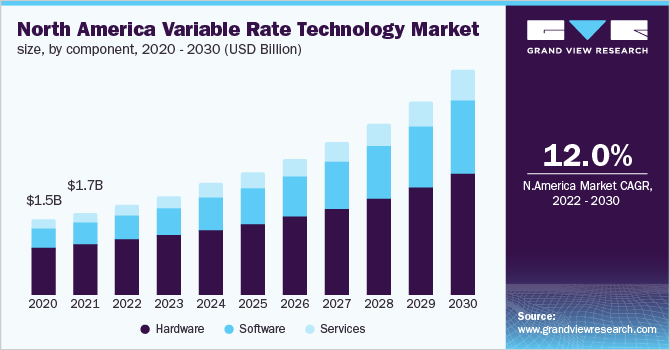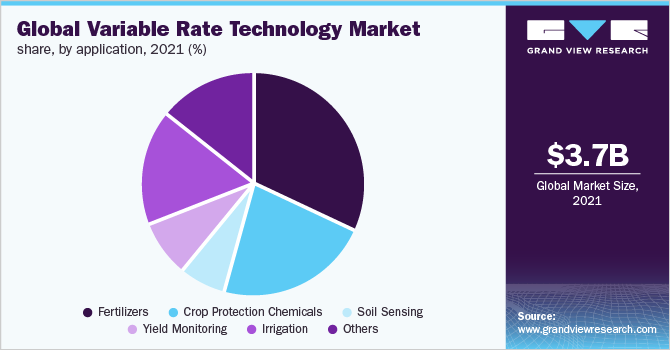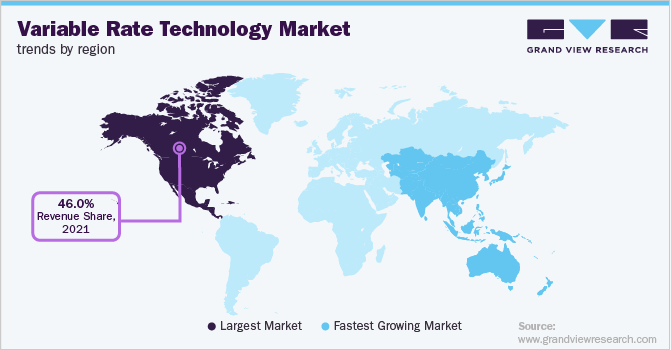- Home
- »
- Next Generation Technologies
- »
-
Variable Rate Technology Market Size & Share Report, 2030GVR Report cover
![Variable Rate Technology Market Size, Share & Trends Report]()
Variable Rate Technology Market Size, Share & Trends Analysis Report By Component (Hardware, Software, Services), By Technology (Map-based, Sensor-based), By Crop Type, By Farm Size, By Application, By Region, And Segment Forecasts, 2022 - 2030
- Report ID: GVR-4-68039-997-4
- Number of Report Pages: 210
- Format: PDF, Horizon Databook
- Historical Range: 2017 - 2020
- Forecast Period: 2022 - 2030
- Industry: Technology
Report Overview
The global variable rate technology market size was valued at USD 3.68 billion in 2021 and is expected to witness a compound annual growth rate (CAGR) of 12.3% from 2022 to 2030. Agricultural variable rate technology sales by entities (organizations, sole proprietors, and partnerships) make up the agricultural variable rate technology market. This technology sector deals with automated applications, with a primary emphasis on the automated applications used in agriculture. Sensors, maps, and GPS are used to gather agricultural data. Variable Rate Technology (VRT) is a tool that allows farmers to apply water, fertilizer, seed, and chemicals at different rates across a field. When one uses VRT to apply an apt amount of nutrients blended with the ideal seeding rate, they can produce more from every acre of their land while reducing the amount of wasted product. They can maximize every opportunity by customizing each zone's seeding and crop nutrition applications. The most and minor fertile areas in each field are checked with complementary seed rates and applications; these pairings are known as prescriptions.

Agriculture VRT suppliers now have more prospects for growth due to the expanding adoption of these cutting-edge agricultural solutions. Technical developments in the machinery utilized to enhance productivity help competitors strengthen their positions in the agriculture variable rate market. With the development of technology, farming procedures will become increasingly automated. Applications of sensors, imaging, control systems, data management, big data, and AI will increase the adoption of VRT, thereby assisting new competitors in securing a foothold in the market.
The variable rate technology market has a vast scope for expansion. To realize this potential, farm operation services, integration services, and consultation services are included. Numerous global businesses offer these services, including farm mapping and soil and moisture management. Companies like Lindsay Corporation offer variable rate irrigation and farm mapping services in several developing nations, helping to promote the adoption of agricultural variable technologies in these nations where farmers cannot afford to install agriculture technology for their farmlands. Under contractual agreements, these market participants offer VRT services for recurring monthly or quarterly fees. The availability of these services in emerging markets helps to raise awareness of the benefits of agricultural variable rate technology over conventional agrarian services.
COVID-19 Impact Analysis
The COVID-19 pandemic outbreak has temporarily decreased demand for agricultural machinery and related technology. The agriculture variable rate technology business has recovered post-pandemic due to the minimal worker engagement required in VRT, as labor costs are increasing by the day. Due to the severe labor scarcity during the pandemic, which adversely affected total productivity, the farmers were compelled to discover the advantages of investing in technologies rather than depending on the workforce. An excellent way to get around these issues is to use variable rate technology in agriculture. Because it helped farmers understand the financial rewards of investing in variable rate technology, COVID-19 has had a beneficial long-term effect on the target market.
Most agriculture technology companies are based in Western Europe and North America. COVID-19 impacted these regions significantly, and economic activities were at the lowest level due to brief shutdown and quarantine measures to fight the deadly COVID-19 pandemic. As a result, the first half of 2020 experienced decreased demand for agriculture supplies and related hardware devices. However, low labor involvement and an increase in labor cost aided in the recovery of the variable rate technology (VRT) market post the pandemic situation went back to normalcy.
Component Insights
The hardware segment dominated the overall market, gaining a market share of 69.87% in 2021, and is expected to witness a CAGR of 10.9% during the forecast period. The guidance and steering systems sub-segment of the hardware segment and the farm operation services sub-segment of the service segment holds the highest market share. Due to its various features, including data security, farm work mapping, crop health monitoring, data administration, and stock management, the variable rate technology software market is predicted to expand rapidly. The widespread use of variable-rate technology, and hardware solutions, including GPS/DGPS receivers, portable computers, sensors, and yield monitor systems, made up about half of the market for VRT offerings.
The software segment is anticipated to witness the fastest CAGR of 15.5% through the forecast period. The farm operation services sub-segment of services segment is expected to see the most rapid growth throughout the forecast period. Crop growers can apply varying amounts of fertilizer at various locations throughout fields by using a fertilizer that is applied at a variable rate. An in-cab computer and software with fertilizer equipment capable of altering rates while in use, a field zone application map, and a Global Positioning System (GPS) are among the pieces of technology required to carry out variable-rate fertilization. In general, VRA (Variable Rate Application) technology is primarily used to gather data on a specific terrain and enable a system to make judgments based on that data. The kind of products to be employed in the field is decided upon by these decisions taken with the help of software. In addition, adopting a VRA system can help automate the entire agricultural process step, which is another advantage. A company can save more money by increasing output and efficiency. These are the main factors driving the revenue growth of this segment.
Technology Insights
The map-based segment dominated the overall market, gaining a market share of 69.45% in 2021 and witnessing a CAGR of 11.3% during the forecast period. Map-based VRT uses an electronic map, sometimes known as a prescription map, to alter the application rate. Using a prescription map of the intended speed and the field position from a GPS receiver, the input concentration as the applicator goes across the field. While some tactics rely on various sources, others depend on a single information source. Regardless of the actual approach, the application rate is ultimately under the user's control. By reading the prescription map, these systems must be able to locate the machine in the field and connect its location to the intended application rate. In terms of technology, the market is classified into map-based and sensor-based. The sensor-based segment is further segmented into active optical sensor VRT, drone-based VRT, and satellite-based VRT.
The sensor-based segment is anticipated to witness the fastest CAGR of 14.3% throughout the forecast period. Sensor-based VRT allows changing the rate at which inputs are applied without requiring prior mapping or data collecting. Real-time sensors take on-the-go measurements of the desired attributes, typically crop traits or soil properties. Such a system then processes the measurements and uses them immediately to operate a variable-rate applicator.
Crop Type Insights
With a market share of 38.18% in 2021 and a projected CAGR of 12.8%, the segment of cereals and grains dominated the total market. The crops that are harvested the most worldwide are grains and cereals. Among the various crop kinds, cereals like wheat, corn, and rice have the highest rate of adoption because they are mostly grown on large farms. Site-specific management of the field variability is possible with the variable input application rates. VRT helps reduce input usage, decreasing environmental impacts such as soil degradation and erosion and greenhouse gas emission. VRT helps increase land and crop productivity and minimizes input waste. The market is divided into categories based on crops grown: cereals & grains, fruits & vegetables, oilseeds & pulses, and commercial crops. Corn, wheat, and other items are further broken down under the heading of cereals and grains. The category of oilseeds and pulses includes sub-segments for products like soybean, cotton, and others.
The commercial crops segment is anticipated to witness the fastest CAGR of 12.2% throughout the forecast period. The wheat sub-segment of cereals & grains and the soybeans sub-segment of oilseeds & pulses segment also anticipated the fastest growth throughout the forecast period. Cereals like wheat have the maximum adoption among different crop types as these are majorly cultivated in large farms. The adoption rate of VRT (variable rate technology) is expected to be high compared to other technologies. VRT helps apply the proper amount of input at a suitable place on the field, which minimizes input waste and increases crop and land productivity.
Farm Size Insight
The large farm segment dominated the overall market, gaining a market share of 59.06% in 2021, and is also anticipated to witness the fastest growth, growing at a CAGR of 12.5% during the forecast period. Large farms mainly adopt the Variable Rate Technology (VRT). The equipment and technologies used in agriculture variable rate, including drones, smart sensors, GPS, VRT, guidance tools, GNSS, and receivers, are highly efficient but costly. Besides, skilled personnel is needed to set up and operate agriculture variable rate equipment. Hence, large farms will need this more than small farms and will be able to purchase technology-based farming. In terms of farm size, the market is classified into large farms, mid-size farms, and small farms.
Agriculture VRT helps mid-sized farms to increase their profitability by regulating the inputs such as chemical fertilizers and crop protection chemicals. Mid-size farms adopt intelligent farming techniques in developed countries such as the U.S., Australia, and United Kingdom. Rising demand for food supply has directed to the increased adoption of precision farming technologies in med-sized farms in developing countries.
Application Insights
The crop protection chemicals segment is further segmented into herbicides, fungicides & bactericides, insecticides, nematicides, and others. The fertilizer segment dominated the overall market, gaining a market share of 32.39% in 2021 and witnessing a CAGR of 12.4% during the forecast period. The NH3 VRT sub-segment of the fertilizer segment and the insecticide sub-segment of the crop protection segment holds the highest market share. Variable-rate fertilizer application allows one to apply various rates of fertilizer in each part of the field. How to distribute fertilizer depends on the planned yield, soil fertility, and factors influencing it. In terms of application, the market is classified into fertilizers, crop protection chemicals, soil sensing, yield monitoring, irrigation, and others. The fertilizers segment is further segmented into Urea VRT, UAN VRT, NH3 VRT, and other VRT.

The yield monitoring segment is anticipated to witness a CAGR of 11.2% through the forecast period. Yield Monitoring is an element of precision agriculture that provides farmers with sufficient information to make knowledgeable decisions about their fields. Yield monitors are a recent development and allow farm equipment to gather a vast amount of information, including moisture levels, grain yield, soil properties, and more.
Regional Insights
North America led the overall market in 2021, with a market share of 46.02%. Due to the significant development in automation and digitalization of agriculture in the area, North America dominates the global market for variable rate technology. The increasing industrialization and digitization of agriculture are building new business standards for the agricultural VRT market. The VRT market in North America is growing yearly due to the expanding crop adoption.

Asia Pacific is expected to witness the fastest CAGR of 14.2% in 2021. The extensive farmlands and rapid population expansion in Asia Pacific are predicted to contribute to the rapid growth of VRT in the future. It is one of the prospective markets for agriculture VRT, as it has extensive farmlands and a high population growth rate. The Asia Pacific has a vast land area, which comprises countries such as Japan, China, South Korea, India, and Australia. Population increase in the region's developing countries puts pressure on the agriculture industry to enhance productivity, fueling demand for VRT (Variable Rate Technologies). Drones used to plant seeds and spray pesticides and fertilizers are becoming increasingly popular in the Southeast Asian country, which is dealing with a workforce shortage exacerbated by the coronavirus outbreak and limitations on employees' migration.
Key Companies & Market Share Insights
The key players in the market are focusing on mergers and acquisitions, and partnerships to expand their market share and product offerings. For instance, In August 2021, Deere and Company acquired Bear Flag Robotics. The agreement complements John Deere's goal to produce more intelligent machines with cutting-edge technology to fulfill unique client requirements and accelerate the farm's development and delivery of automation and autonomy. In December 2021, NX9 was acquired by CNH Industrial N.V. NX9 was a software suite that delivers ISOBUS core technologies and applications for agriculture equipment and related intellectual property rights. This latest R&D acquisition builds upon the company's strategic momentum to more efficiently develop and innovate products in the precision agriculture space and provide superior value for its farming clients. Some of the prominent players in the variable rate technology market include:
-
Trimble Inc.
-
Deere & Company
-
AGCO Corporation (US)
-
Topcon Corporation
-
CNH Industrial NV
-
Kubota Corporation
-
Yara International
-
Valmont Industries, Inc.
-
Lindsay Corporation
-
Hexagon
-
AgJunction
Variable Rate Technology Market Report Scope
Report Attribute
Details
Market size value in 2022
USD 4.0 billion
Revenue forecast in 2030
USD 10.3 billion
Growth Rate
CAGR of 12.3% from 2022 to 2030
Base year for estimation
2021
Historical data
2017 - 2020
Forecast period
2022 - 2030
Quantitative units
Revenue in USD million and CAGR from 2022 to 2030
Report coverage
Revenue forecast, company ranking, competitive landscape, growth factors, and trends
Segments Covered
Component, technology, crop type, farm size, application, region
Regional scope
North America; Europe; Asia Pacific; South America; MEA
Country scope
U.S.; Canada; Mexico; U.K.; Germany; France; Italy; Japan; China; India; Australia; Brazil
Key companies profiled
Trimble Inc.; Deere & Company; AGCO Corporation (US); Topcon Corporation; CNH Industrial NV; Kubota Corporation; Yara International; Valmont Industries, Inc.; Lindsay Corporation; Hexagon; AgJunction
Customization scope
Free report customization (equivalent up to 8 analysts working days) with purchase. Addition or alteration to country, regional & segment scope.
Pricing and purchase options
Avail customized purchase options to meet your exact research needs. Explore purchase options
Global Variable Rate Technology Market Segmentation
The report forecasts revenue growth at global, regional, and country levels and provides an analysis of the latest industry trends in each of the sub-segments from 2017 to 2030. For the purpose of this study, Grand View Research has segmented the global variable rate technology market report based on component, technology, crop type, farm size, application, and region:
-
Component Outlook (Revenue, USD Million, 2017 - 2030)
-
Hardware
-
Guidance and Steering systems
-
Flow and Application Control Devices
-
GPS/ DGPS Receivers
-
Handheld Mobile Devices/Computers
-
Yield Monitors
-
Others
-
-
Software
-
Services
-
Farm Operation Service
-
Integration and Consultation Services
-
-
-
Technology Outlook (Revenue, USD Million, 2017 - 2030)
-
Map-based
-
Sensor-based
-
Active Optical Sensor VRT
-
Drone-based VRT
-
Satellite-based VRT
-
-
-
Crop Type Outlook (Revenue, USD Million, 2017 - 2030)
-
Cereals and Grains
-
Corn
-
Wheat
-
Others
-
-
Fruits and Vegetables
-
Oilseeds and Pulses
-
Soybeans
-
Cotton
-
Other
-
-
Others
-
-
Farm Size Outlook (Revenue, USD Million, 2017 - 2030)
-
Large farms
-
Mid-sized Farms
-
Small Farms
-
-
Application Outlook (Revenue, USD Million, 2017 - 2030)
-
Fertilizers
-
Urea VRT
-
UAN VRT
-
NH3 VRT
-
Other VRT
-
-
Crop Protection Chemicals
-
Herbicides
-
Fungicides & Bactericides
-
Insecticides
-
Nematicides and others
-
-
Soil Sensing
-
Yield Monitoring
-
Irrigation
-
Others
-
-
Regional Outlook (Revenue, USD Million, 2017 - 2030)
-
North America
-
U.S.
-
Canada
-
Mexico
-
-
Europe
-
U.K.
-
Germany
-
France
-
Italy
-
-
Asia Pacific
-
China
-
Japan
-
India
-
Australia
-
-
South America
-
Brazil
-
-
Middle East & Africa
-
Frequently Asked Questions About This Report
b. The global variable rate technology market size was estimated at USD 3.68 billion in 2021 and is expected to reach USD 4.0 billion in 2022.
b. The global variable rate technology market is expected to grow at a compound annual growth rate of 12.3% from 2022 to 2030 to reach USD 10.3 billion by 2030.
b. North America dominated the variable rate technology market with a share of 46.02% in 2021. This is attributable to growing adoption of technology for several agricultural operations such as measured application of inputs including fertilizer, crop protection chemicals, water.
b. Some key players operating in the variable rate technology market include Deere & Company, Trimble, Inc., AGCO Corporation, Topcon Corporation, CNH Industrial NV, Kubota Corporation, and Yara International. .
b. Key factors that are driving the variable rate technology market growth include rising labor costs, need for variable inputs in the agriculture fields, and rising demand for food due to the growing population.
Share this report with your colleague or friend.
![gvr icn]()
NEED A CUSTOM REPORT?
We can customize every report - free of charge - including purchasing stand-alone sections or country-level reports, as well as offer affordable discounts for start-ups & universities. Contact us now
![Certified Icon]()
We are GDPR and CCPA compliant! Your transaction & personal information is safe and secure. For more details, please read our privacy policy.
We are committed towards customer satisfaction, and quality service.
"The quality of research they have done for us has been excellent."





